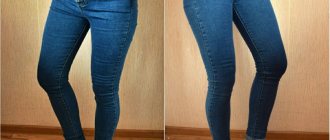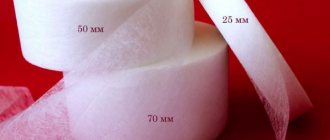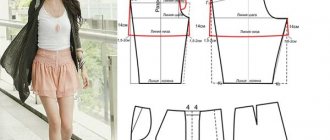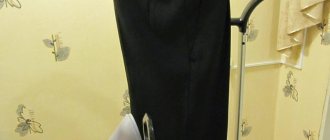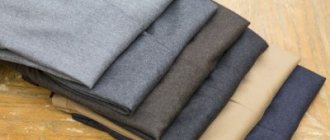Hemming trousers or sewing the hem of a skirt by hand is not always as easy as it seems. In the atelier, classic men's or women's trousers are hemmed on a special machine. Instead of thread, transparent thread (monofilament) is often used, so the hemming seam is not visible from the front side.
The hem of the bottom of men's trousers is first overlocked using an overlocker, then the trouser tape is sewn on with two lines using a machine. For women's trousers, braid is not used. Sometimes, depending on the type of fabric and model of trousers, a finishing stitch is used instead of a hidden hem stitch. Basically, this treatment is used to secure the hems of knitted and children's trousers.
In this video you will learn how to hem men's trousers with trouser tape on a sewing machine. The hem of the trousers is secured with a hidden hand stitch.
At home, trousers must be hemmed manually using a hidden seam. In most cases, you can even fix the hem with a web, but be sure to duplicate it with a hidden stitch. In any case, it is advisable to know some of the features of this technology in order to hem trousers correctly and beautifully. How to hem trousers so that the seam does not “pull” and the hand-stitched threads do not come out on the front side, the tape does not “fray”, etc. Check with a professional tailor for recommendations.
Flower nursery Green Gate
Do you like indoor or garden flowers? At the Green Gate nursery you can buy rooted cuttings and divisions of various domestic and perennial garden flowers. We have a constantly updated collection of anthuriums and hibiscus. Flowers and plants are sent by mail.
How to shorten trousers so that the seam on the front side is not visible?
This method is suitable if you want to fold the bottom:
- for men's or women's suit trousers, they can be either tapered or wide at the bottom;
- school trousers, in which you can leave extra length for growth;
- beautifully shorten jeans without finishing the top;
- if you want to do this at home without a sewing machine by hand.
Many people, looking at the hem of a product, often understand how it was made. But even in the simple version there are some secrets that make the work easier and faster.
The saved time can be spent on creativity, reading books, on family, in the end, on yourself (often there is not enough time for this) and on much more.
This master class will be useful not only for beginning craftswomen. Experienced craftswomen can also find something new for themselves. Practical advice very often helps out, oh, how it helps)))
For work we will need:
- Chalk or soap
- Scissors
- Pins
- Needle
- Threads
- Overlock
- Hook
- Iron
Progress:
- We try on the product, if we wear a belt or a belt, we put it on, because the trousers will rise up a little. If this is not done before hemming, it is very possible that they will be too short.
- We put on shoes and mark the desired length, taking into account desires, fashion trends and the width of the leg. If the trousers are narrow at the bottom, they are hemmed shorter; if the trousers are wide, they are hemmed longer. If you like trousers of medium length and classic width, measure them to the middle of the heel. In front, to avoid creases, you can shorten the front part by 0.5 - 1 cm.
- And so, you marked the desired length with a pin, then mark (bend) the second leg too. For accuracy, you can use a ruler and measure the distance from the floor to the selected length along the first leg, set aside the same amount along the second and bend it.
Why do this? It's no secret that we are not symmetrical and often when hemming trousers, focusing on one leg, in the end we find that they are not equal in the back, one is higher than the other. But I don’t want to redo it, oh I don’t want to)))
- Let's move on. Our product is on the table with the hemming points marked. Photo 1.
- We are not in a hurry to cut, we measure the side seams, photo 2. As you can see, one pant leg is 1 cm longer than the other, photo 3.
In mass-sewn trousers in my practice (25 years), the difference reached 3 cm. I think that in that case the height of one of the legs was mixed up. But if we don’t think about it in advance, it’s up to us to redo it later, not them)))
- With chalk we draw a line along which we will bend, below, retreating 3-3.5 cm, another line along which we will cut. Please note that I took into account the difference in the legs))). Picture 4.
- Take scissors and cut along the bottom chalk line. I advise you to cut it in one layer of material, as it happens that the fabric shifts and the bottom turns out uneven and sloppy. Picture 5.
- Now, we overlock the bottom of the trouser leg with an overlocker, leave the tail longer and tuck the hook into the overlock stitch. Picture 6.
- Our next step will be to mark the bottom along the chalk line. But I suggest you save time and go straight to the iron. For convenience, we turn the trouser leg inside out, put it on the ironing board for the sleeves and fold it along the chalk line and fix it, smoothing it with an iron. Picture 7.
- Next, we thread a thread of a suitable color into a needle and make a cross stitch. We start with the inner seam allowance of the leg (the seam between the legs).
At the seam allowance (the folding part), we pierce the material through the base of the overlock seam (from the wrong side it will look neat). From the side of the trouser leg itself, we grab 1-2 threads of fabric so that there is no trace on the front side. Picture 8 -9.
- The movement of the needle is always from right to left, so in the end you get a cross, photo 10 - 11.
- The finished seam looks as shown in Image 12. A correctly made blind seam (it is not visible) holds up better than a production machine hem seam.
- After going around the leg and securing the end of the seam well, we begin ironing. Steam the bottom of the product. All is ready. Photo 13.
I hope that it was useful for a novice craftswoman to learn the sequence of actions when hemming.
Further, in subsequent articles, we will analyze all types: double hem of jeans, hem in which the original seam remains, hem of trousers with braid (often used when shortening suit trousers), skirts, dresses, knitwear.
If you have questions, write your wishes in the comments. We'll look into everything and answer all questions.
Subscribe to receive new publications. Share the link with your friends and reach sewing heights.
All the best to you! Ilona was with you
If this article was useful to you, rate it - light a heart)))
Preparing to shorten your trousers
What materials and tools to prepare
To hem your pants you will need the following.
Tools:
- scissors;
- needle;
- ripper;
- pins;
- ruler;
- tape measure;
- soap (dry)/chalk;
- iron.
Materials:
- braid;
- cobweb;
- threads in the color of the trousers or darker.
How to prepare pants legs for shortening
Before changing the length of the product, it must be measured correctly. It is better to do this directly on the owner of the clothing.
And if this is not possible, take other trousers, turn them and new trousers inside out. Attach both items to each other along the crotch seam. Use chalk or soap to draw a line of the required length.
First way to mark length
- Lay out the item you plan to hem on a wide table.
- Transfer the marked line of the future cut to the front side.
- We mark a right angle from the arrow line on the trousers .
- Draw a dotted line along the trouser leg .
- Set aside 3.5 cm down and draw a parallel line. This will be the cut point.
- Straighten the trouser legs and place them on top of each other . For reliability, you can pin them together with pins/needles.
- Be sure to place pins along the future hem line .
- The fabric is fixed and will not move, so cut the length without fear.
Advice. You can cut off the legs one by one. Along the cut edge of the first leg, mark the cutting line with chalk, secure with pins and shorten the second leg.
Second way
- From the bottom of the trousers to the cutting line along the entire perimeter of the legs, use a ruler to set aside the required number of centimeters and place dots .
- soap along the marked marks .
- Make sure it is parallel to the bottom edge of the pants.
- Use scissors to cut off the excess length.
Once the excess fabric has been removed, you can begin hemming and processing the cut. Without a sewing machine, the job can be done in several ways. Let's look at each of them.
We hem tapered men's trousers correctly
First, you need to decide how to care for the item. If you plan to wash it at home, first you need to wash the item. There is a possibility that the fabric will shrink after washing.
How to shorten skinny men's trousers
Reference! There is a simple rule for choosing the length: the narrower the width of the trousers, the shorter they are.
If a man's pants have a bottom width of less than 22 cm, they are considered skinny. The recommended length for them is the middle of the heel . In front they gather into one soft fold on the lower leg.
Jeans are tried on in the same way as classic men's trousers. Very skinny jeans cover the top of the shoe without wrinkles, those that are wider gather in front into a crease on the shin.
Important! You need to try on pants with shoes and a belt.
The hem can be marked using pins or tailor's chalk.
Technology for hemming tapered men's trousers
The choice of hem processing depends on the model and the material from which they are sewn. It is best to bend using the same method chosen by the manufacturer.
For suit trousers, the trouser braid treatment is used.
Advice! The braid can be wetted or ironed with steam before use.
Having combined both trouser legs in the belt, you need to lay them out on the table. Using the marks you need to mark the hem line for the bottom. Place the hem line down and trim the excess fabric along it.
Hemming trousers using a web
The web is very convenient to use for hemming the bottom of the product. It’s just not advisable to glue the hem of a skirt made of thin and “delicate” fabric. The cobweb will definitely be “stamped”, and the bottom of the skirt will become stiff. It is better to hem the skirt by hand, with a very thin thread and needle. In other cases, it is better to use the adhesive web in combination. That is, first fix the hem of the trousers with a web. After this, you can also hem them manually, since adhesive materials lose their properties due to frequent washing and over time, the glued area will come loose and you will have to hem the trousers by hand.
Some tips
For high-quality hemming of jeans at home, you need, first of all, a beautiful finishing stitch. The thread for the finishing stitch should be of a suitable shade and thicker than for regular stitches. Some sellers call it denim thread because of the thickness and quality of the fiber.
There are special needles on sale for sewing denim; they differ in the shape of their point and improve the quality of the stitching.
Advice! Home sewing machines do not always cope with thickenings such as hems in the area of the side seams. You can make the machine's work easier by pre-cutting the seam allowances at an angle.
You can hem the bottom of suit trousers without using a sewing machine. If you don't plan to wear the trousers every day, you don't need a special braid.
The cut of the bottom of the trousers can be hemmed with a goat seam. This seam securely secures the hem of the trousers and prevents the fabric from fraying.
If braid is not selected for hemming a suit, it can be replaced by cut fabric from the bottom of the trousers.
Good luck to everyone in fitting your favorite pants, it really is an easy and enjoyable job!
Hemming by hand
The technological process for manual hemming is called a “secret seam”. It is almost the same as the previous one. Only the conclusion is different.
- First, measure the length and put the first mark.
- We set aside 3-4 cm from it and put a second mark. Let's try on the product. If the result is satisfactory, you can begin the main work.
- Using scissors or a sewing cutter, cut off the unnecessary fabric.
- We process the edge of the product to prevent fringe.
- Now we fold the edge from the outside to the wrong side and secure it with safety pins.
- Using a thin needle, apply a suture. We process along the entire diameter, gradually removing excess pins.
Advice: it is better to stitch the product using one thread.
Carefully treat the area with a hot iron, avoiding the seams. The trousers are ready.
The correct length of men's trousers: tips from a tailor
Modern fashion is rapidly moving ahead, destroying more and more stereotypes and standards every year. Yes this is true. Nevertheless, the rules are still relevant and remain unshakable. For example, there are requirements regarding the length of trousers. Some men for some reason do not take them into account. As a result, they either look oversized because their trousers are too short for them, or they sweep the street with long trousers. This sight looks absolutely unacceptable for a man who cares about his appearance.
There is a generally accepted standard according to which trousers should cover no more than the heel of the shoes from the back, and leave about one fold from the front. But it's not that simple. It should be taken into account that there are now a lot of varieties of men's trousers. Therefore, this standard does not always work. That's why we decided to tell you about what length of trousers is considered acceptable for a particular style.
What length should the trousers be?
The length of the pants directly depends on the width of the product styles. There is a classic rule to remember: tapered pants should be shorter and flared ones should be longer.
Women's trousers length
According to the laws of etiquette, women's pants should reach the heel. It looks gentle, beautiful and visually the legs become longer. This length would be considered traditional, but in recent days there are a lot of new styles appearing, so it is difficult to say about a single correct length of trousers. Such standards are no longer suitable for bell-bottom trousers.
Bottoms in denim pants
Correct trouser length for different models:
- Direct. Length reaches ½ heel. Visually, the legs look longer and slimmer. This also applies to jeans;
- Pipes. Styles with a loose fit from the hip point. Pants that are too short will visually make your hips appear fuller. With a good cut, almost the entire heel is not visible, but the toe should stick out. The correct distance from the ground is 2 cm;
- With arrows. The style is suitable for the office, straight, reaching to the middle of the heel, with smooth arrows on both sides;
- Sports. If you choose correctly, you will feel comfortable and soft when playing sports. If the trousers have an elastic band, then the ankle should not be visible.
Options for the correct length of pants
Expert opinion
Mikhailov Ivan Maksimovich
Furniture maker. Work experience 3 years.
Sweatpants have their own nuances. Since the pants are knitted, it is not always possible to do this by hand. Tailors use special machines for this, but at home it can be done using a regular overlocker.
To prevent the fabric from puffing up, craftsmen suggest using needles with slightly rounded ends. To make the material stretch better, it is advisable to place a thin strip of paper. Process of working with sweatpants:
- Measure the material for bending and cut it;
- Go over the edges with an overlocker;
- Fix the bends;
- Sew from the inside.
Next, you need to make another seam at a distance of 4 mm. If the zipper is on the side, then it needs to be opened, making 5 cm on the bend.
Women's pants with stripes
Pants with stripes are hemmed in the place where the decorative seam is located. The same is permitted if the product has an elastic band.
Important! The main disadvantage of knitwear is that it quickly stretches under the influence of mechanical factors. To avoid this, it is advisable to use a special foot to carefully advance the material during work. New styles of sewing machines have an additional stitch for such fabric.
Men's trouser length
When buying pants, you need to try on as many models as possible. Since it is very difficult to find the right one the first time. Sometimes stores offer a service for adjusting pants on the spot. It is advisable to wear the shoes that you plan to wear with trousers.
Classic men's trousers and oxfords
Note! It doesn’t matter what kind of pants you buy, the main thing is that they fit well and match the shoes.
For formal events, it is better not to wear short styles, such as slacks, joggers, and chinos. They will be tapered to the ankle, suitable for everyday wear. For celebrations, it is better to wear classic trousers and oxfords.
Classic pants
Classic always implies strict adherence to the rules. Pants length is no exception. Let's start with loose-fitting models with an arrow in the center of the legs. This style is usually chosen by middle-aged men or if they want to hide figure flaws. In these trousers, the back of the trouser leg should be located no more than one centimeter above the heel, but at the same time not fall below its middle. It is important that in front it covers 2/3 of the shoe, leaving only 1/3 of the shoe or shoe visible. In this case, the trouser leg in the shin area most often breaks into one fold.
Now let's move on to classic trousers with a loose fit and rolled cuffs. They should lie lightly on the shoes without forming a crease in the trouser leg. Most often, the distance from the hem of the trouser leg to the heel in such models is 2-2.5 cm.
Machine hem sequence
So, the length has been chosen. Now you need to carefully trim.
- First, fold both halves of the trousers together and place them on the table.
- Pin along the sides, along the waistline, so that they do not move.
- Measure the required length and draw a thin strip with chalk.
- Step back 2-3 cm from the selected length and again draw a strip with chalk. (If the material is too thin, then step back 4-4.5 cm).
- Cut off the excess.
- Fold, baste with stitches, stepping back from the bottom by 5-6 millimeters. Then make another basting stitch.
- Then connect both trouser legs to double check that the hem is even.
- Tip: try on the product again so you don’t doubt the length you choose.
- Cut both legs at once; if the material is too thick, cut one at a time.
- Use an overlocker or zigzag stitch along the cut edge.
- If you did everything correctly, fold it, iron it through gauze, and sew it on a machine.
- Remove the basting and iron it.
Tapered trousers
The most popular in recent years are tapered trousers. On the one hand, they are suitable for creating everyday looks, on the other hand, they are also appropriate for classic looks. Most often, such trousers are suitable for smart casual style. They can be either with or without rolled cuffs. In any case, the standard according to which the optimal length of the trouser leg reaches the middle of the heel does not apply to them.
Tapered trousers should form a single pleat at the front, but may be shorter at the back than mid-heel. Such models, as a rule, initially have a shorter length to maintain proportionality. It is optimal for the top of the shoe to be visible from under the legs, for example, the lacing, if these are Oxfords or Derbys.
It is no longer possible to imagine a men's wardrobe without jeans. After all, they are comfortable, practical and fashionable. But how long should jeans be? If they have a straight cut or are slightly tapered at the bottom, then:
- there should be one fold above the shoe in front, but no more than 3 cm;
- The shoes are covered at the back so that the edge of the trouser leg does not touch the floor;
- The distance from the bottom of the jeans to the sole or heel should be approximately 2 cm.
Skinny jeans, which fashionable men love so much, have different requirements. If you plan to wear denim trousers with sneakers or sneakers, then their length should end where the top of the shoe begins or be located slightly below this level (approximately around the ankle). Please note that skinny jeans should not be pulled over shoes. It is also acceptable to wear them with slight pleats at the bottom or with the cuffs rolled up.
Both young guys and older men love chinos alike. After all, they are suitable for work, where there is no strict dress code, and for everyday wear. When choosing the optimal length of chinos, make sure that they do not bunch up at the bottom. In this case, the formation of a small fold in the lower part or its absence in the form of an absolutely straight trouser leg is acceptable.
How to find out the length you need?
If you are wondering how to properly shorten men's trousers, then first of all you need to decide on their length. To find out the correct length for your pants, try wearing them with the boots you'll most likely wear them with. Even flat shoes raise your foot a little, so it's important to try on your pants with your shoes. After this, you need to roll up the pants to get the right length. The bottom of the legs should be pinned to make it easier to shorten. Of course, it is necessary for someone to help, since you can make a mistake with the sizes yourself.
Velvet pants
Loose-fitting trousers, as well as tapered models, are made from corduroy. The length of the second option is subject to the same requirements that we have already considered earlier. As for wide corduroy trousers, their trouser leg should reach the middle of the heel and cover the shoes, right up to the edge of the lacing.
The main difference between cargo and other trousers is the presence of patch pockets on the buttocks and legs. The length of these models should be optimal to reach the shoes. In this case, the trouser leg, as a rule, lies slightly on it, without forming folds, but also without sinking to the floor.
Shortening with glue
You don't have to use a sewing machine to shorten your pants. To do this, you can use regular fabric glue. If the glue does not squeeze out, use a small nail to clear a path for it. Spread glue to one side of the original hem on both legs. Fold them like you would fold the cuffs on a shirt. That is, you need to roll them a little inside. Press firmly to secure the adhesive in place. Then turn the pants over again and do the same on the other side.
Once both sides are glued, place something heavy (like books) on the legs to keep them stationary until the glue dries.
How to hem trousers: finishing the bottom of trousers with trouser braid
August 17, 2018
Processing the bottom is one of the final operations when sewing trousers. Its main task is to give the product a finished look and protect the edges from wear during use.
However, you need to decide on the method of processing the bottom of the trousers even before cutting the main parts (the back and front halves of the trousers), because In each case, you need your own allowance for processing.
The sequence of hemming trousers with a hidden seam
For example, for jeans, you can make a visible seam, because this is required by the product model itself. But for classic trousers, a hidden seam is required so that it does not stand out against the general background.
Often craftswomen do not perform an invisible seam because it is difficult. In this case, you can use the services of an atelier. But it’s quite possible to learn how to do it yourself.
Hand-made blind seam
This seam gets its name because it is not visible on the product, as it is hidden between the fabrics. You can take threads 2 tones lower. Shortening process:
Making an invisible seam
- Turn the trousers inside out and secure with pins;
- Check the side arrows, they must be aligned;
- Insert the needle to the other side;
- Sew until the end with a distance of 3 mm.
We sew trousers with a blind seam on a machine
Fold the excess fabric outward, mark the fold with a marker and secure with pins. If the body is asymmetrical, each leg is marked.
Before work, lay your pants out on the table or floor. The trouser legs are folded seam to seam, the waist line also coincides. To prevent the material from fidgeting, you can pin it with safety pins. Next, the machine is adjusted to the desired seam and work begins.
